Activated mutants of SHP-2 preferentially induce elongation of Xenopus animal caps
- PMID: 10594032
- PMCID: PMC85085
- DOI: 10.1128/MCB.20.1.299-311.2000
Activated mutants of SHP-2 preferentially induce elongation of Xenopus animal caps
Abstract
In Xenopus ectodermal explants (animal caps), fibroblast growth factor (FGF) evokes two major events: induction of ventrolateral mesodermal tissues and elongation. The Xenopus FGF receptor (XFGFR) and certain downstream components of the XFGFR signal transduction pathway (e.g., members of the Ras/Raf/MEK/mitogen-activated protein kinase [MAPK] cascade) are required for both of these processes. Likewise, activated versions of these signaling components induce mesoderm and promote animal cap elongation. Previously, using a dominant negative mutant approach, we showed that the protein-tyrosine phosphatase SHP-2 is necessary for FGF-induced MAPK activation, mesoderm induction, and elongation of animal caps. Taking advantage of recent structural information, we now have generated novel, activated mutants of SHP-2. Here, we show that expression of these mutants induces animal cap elongation to an extent comparable to that evoked by FGF. Surprisingly, however, activated mutant-induced elongation can occur without mesodermal cytodifferentiation and is accompanied by minimal activation of the MAPK pathway and mesodermal marker expression. Our results implicate SHP-2 in a pathway(s) directing cell movements in vivo and identify potential downstream components of this pathway. Our activated mutants also may be useful for determining the specific functions of SHP-2 in other signaling systems.
Figures




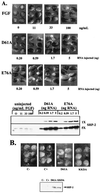
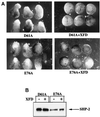
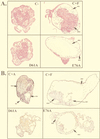

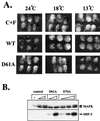
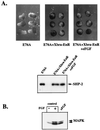
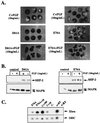

Similar articles
-
Abnormal mesoderm patterning in mouse embryos mutant for the SH2 tyrosine phosphatase Shp-2.EMBO J. 1997 May 1;16(9):2352-64. doi: 10.1093/emboj/16.9.2352. EMBO J. 1997. PMID: 9171349 Free PMC article.
-
A common requirement for the catalytic activity and both SH2 domains of SHP-2 in mitogen-activated protein (MAP) kinase activation by the ErbB family of receptors. A specific role for SHP-2 in map, but not c-Jun amino-terminal kinase activation.J Biol Chem. 1998 Jul 3;273(27):16643-6. doi: 10.1074/jbc.273.27.16643. J Biol Chem. 1998. PMID: 9642214
-
Role of SHP-2 in fibroblast growth factor receptor-mediated suppression of myogenesis in C2C12 myoblasts.Mol Cell Biol. 2002 Jun;22(11):3875-91. doi: 10.1128/MCB.22.11.3875-3891.2002. Mol Cell Biol. 2002. PMID: 11997521 Free PMC article.
-
Revealing mechanisms for SH2 domain mediated regulation of the protein tyrosine phosphatase SHP-2.Structure. 1998 Mar 15;6(3):249-54. doi: 10.1016/s0969-2126(98)00027-6. Structure. 1998. PMID: 9551546 Review.
-
Cytoplasmic protein tyrosine phosphatases SHP-1 and SHP-2: regulators of B cell signal transduction.Curr Opin Immunol. 2000 Jun;12(3):307-15. doi: 10.1016/s0952-7915(00)00092-3. Curr Opin Immunol. 2000. PMID: 10781410 Review.
Cited by
-
PTPN11 is the first identified proto-oncogene that encodes a tyrosine phosphatase.Blood. 2007 Feb 1;109(3):862-7. doi: 10.1182/blood-2006-07-028829. Epub 2006 Oct 19. Blood. 2007. PMID: 17053061 Free PMC article.
-
Molecular mechanisms of SH2- and PTB-domain-containing proteins in receptor tyrosine kinase signaling.Cold Spring Harb Perspect Biol. 2013 Dec 1;5(12):a008987. doi: 10.1101/cshperspect.a008987. Cold Spring Harb Perspect Biol. 2013. PMID: 24296166 Free PMC article. Review.
-
Noonan syndrome/leukemia-associated gain-of-function mutations in SHP-2 phosphatase (PTPN11) enhance cell migration and angiogenesis.J Biol Chem. 2009 Jan 9;284(2):913-20. doi: 10.1074/jbc.M804129200. Epub 2008 Nov 13. J Biol Chem. 2009. PMID: 19008228 Free PMC article.
-
Interaction of the tyrosine phosphatase SHP-2 with Gab2 regulates Rho-dependent activation of the c-fos serum response element by interleukin-2.Biochem J. 2004 Sep 1;382(Pt 2):545-56. doi: 10.1042/BJ20040103. Biochem J. 2004. PMID: 15170389 Free PMC article.
-
Grb2 binding induces phosphorylation-independent activation of Shp2.Commun Biol. 2021 Apr 1;4(1):437. doi: 10.1038/s42003-021-01969-7. Commun Biol. 2021. PMID: 33795832 Free PMC article.
References
-
- Allard J D, Chang H C, Herbst R, McNeill H, Simon M A. The SH2-containing tyrosine phosphatase corkscrew is required during signaling by sevenless, Ras1 and Raf. Development. 1996;122:1137–1146. - PubMed
-
- Amaya E, Musci T J, Kirschner M W. Expression of a dominant negative mutant of the FGF receptor disrupts mesoderm formation in Xenopus embryos. Cell. 1991;66:257–260. - PubMed
-
- Barford D, Neel B G. Revealing mechanisms for SH2 domain-mediated regulation of the protein tyrosine phosphatase SHP-2. Structure. 1998;6:249–254. - PubMed
-
- Barrett K, Leptin M, Settleman J. The Rho GTPase and a putative RhoGEF mediate a signaling pathway for the cell shape changes in Drosophila gastrulation. Cell. 1997;91:905–915. - PubMed
Publication types
MeSH terms
Substances
Grants and funding
LinkOut - more resources
Full Text Sources
Other Literature Sources
Research Materials
Miscellaneous
